Establishment of minimal irrigation garden in Central Portugal
At the end of 2019, I travelled to Portugal with the aid of bursary from MPG, the RHS and the HPS to take part in a project led by Dr. Noel Kingsbury.
I had been studying part-time for my RHS level 3 exams when I was offered the chance to be involved at an early stage in the establishment of a one hectare sustainable garden in Central Portugal under the guidance of Dr. Kingsbury, an expert in water-wise gardening. The objectives of my visit were to gain practical experience in different garden settings and learn about drought-tolerant flora. My tasks would include mapping the property, propagation, preparing new beds, planting borders and trees and pruning established trees.
This sort of planting works very well for Central and Northern European conditions and the assumption is that it should work well in Portugal too. Most of these plants will die back around June when the dormant season starts and come back in October.
Therefore to provide interest in summer there will be sub-shrubs (e.g. Cistus ´Pink Silk‘, Ruta graveolens and Pistacia lentiscus) and grasses with their attractive seed heads. Stipa gigantea as a native species has been propagated and is to be planted as a theme plant for its strong visual properties. The ultimate aim is to create a meadow-like look.
Flammability is an important consideration. Generally, native deciduous trees are far less flammable than conifers e.g. popular designer’s choice Cupressus sp., so there will be an emphasis on planting those. Liquidambar saplings were put in for autumn colour as well as Arbutus unedo and Pinus pinea. Citrus species were introduced to provide greater variety of edibles (Dr. Kingsbury´s wife Jo is very keen on vegetable growing). Quercus robur, already present in the garden as a native species, survived the fires quite well and there are plenty of new saplings too. Prunus lusitanica, which is, ironically, not used much in Portugal planting, has been planted as an axial feature.
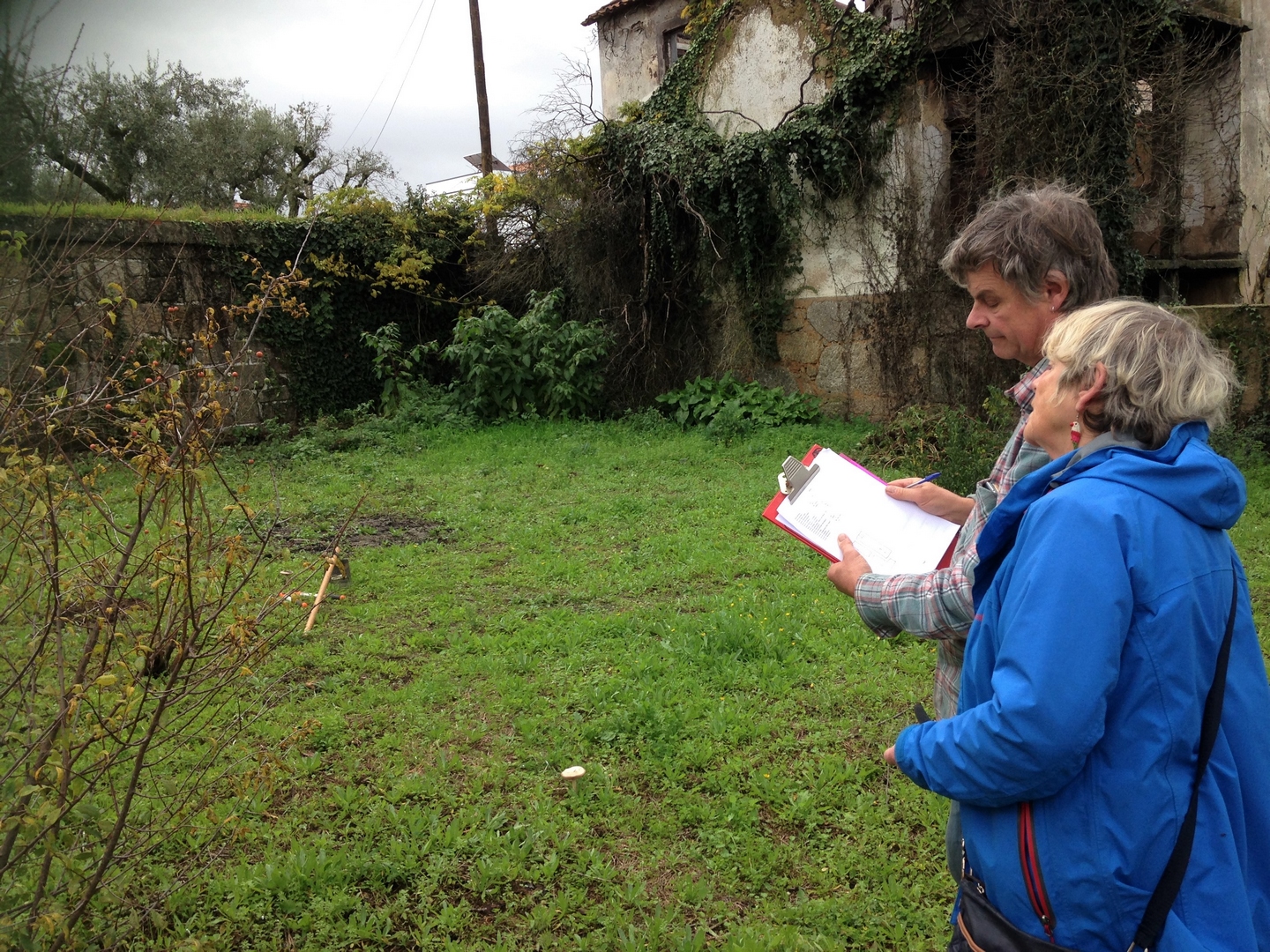
Noel and Jo Kingsbury deciding about the layout
Dr. Kingsbury´s aim is to use the concept promoted by the pioneer of water-wise gardening Olivier Filippi. Classic grass mixtures are substituted by a more hardy and resilient type of planting (e.g. Trifolium sp.) and as an interesting alternative, hardy, foot traffic tolerant plants such as Thymus sp. will be used on the edges of gravelled paths.
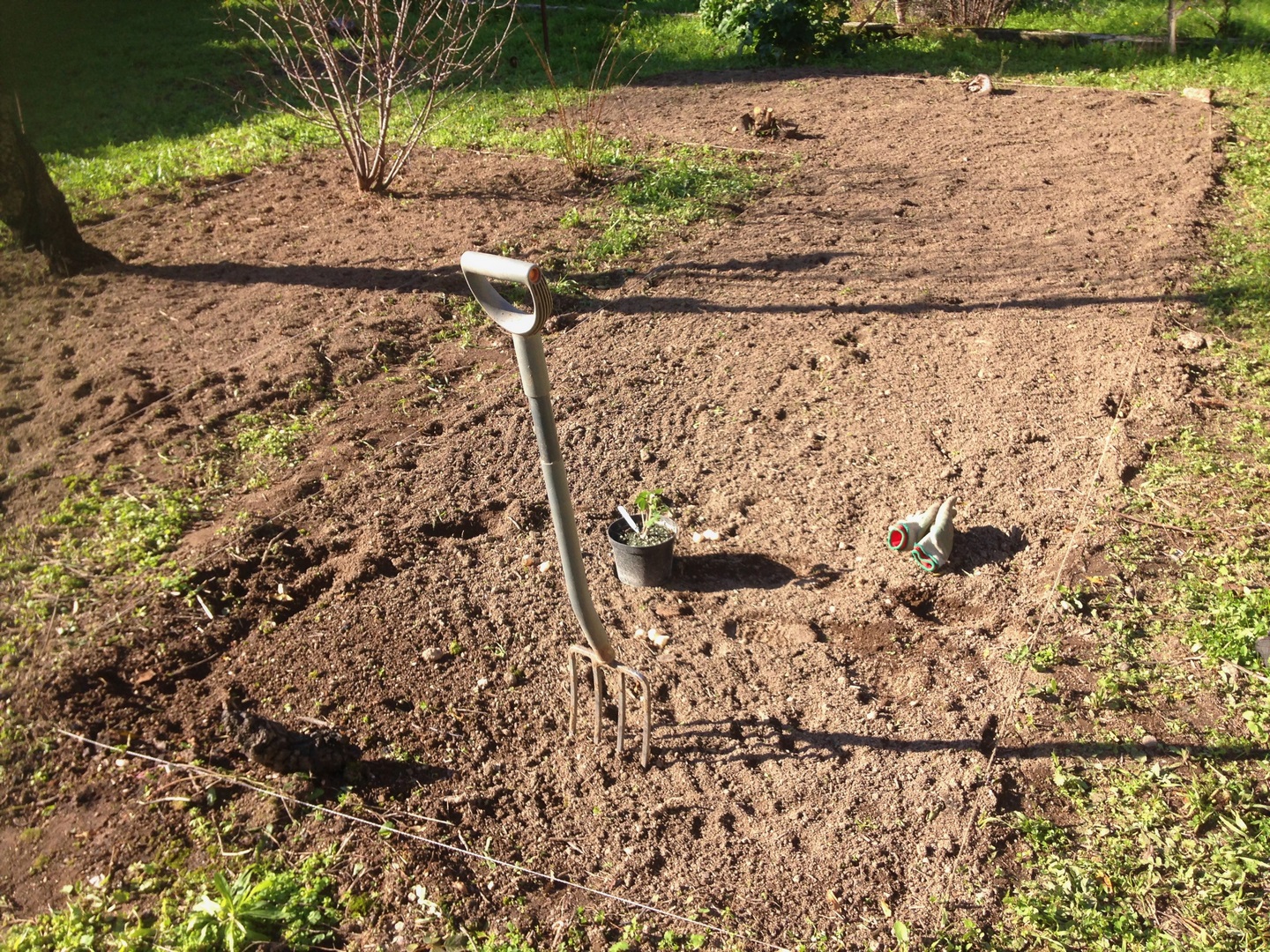
Preparation of formal borders
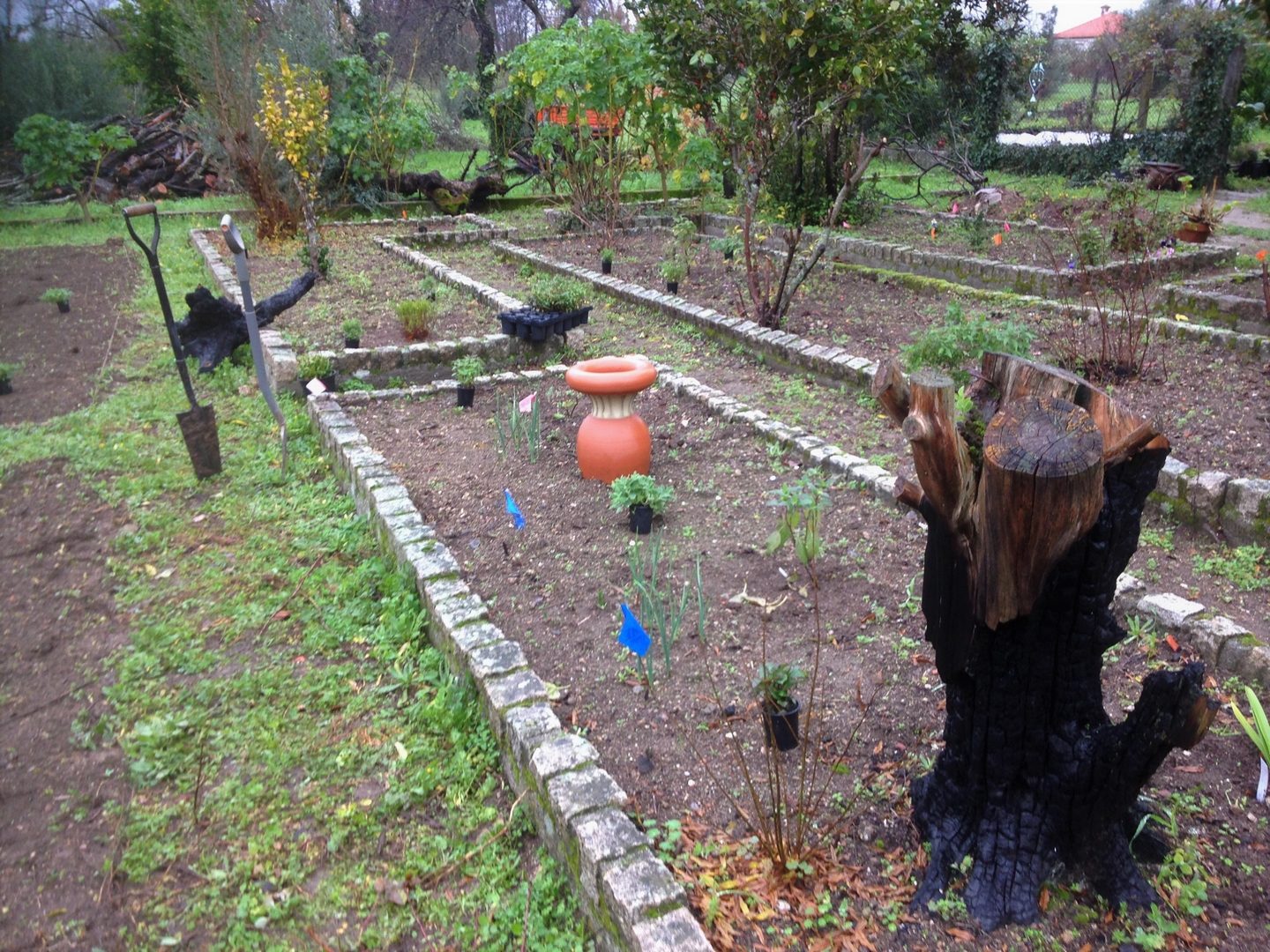
Part of the garden is used as a trial site where all new plants are to be tested and, if successful, propagated. The challenges are expected to be competing weeds and tolerance of very dry summers and rather wet and cold winters. Otherwise the soil seems to be fertile, pH 6.0-6.5, high P, K, low N.
As the garden is in its initial stage the tasks I was mostly involved with concentrated on preparation of borders (measuring and cultivation) followed by planting. I also did some excavation of old roses and uprooting of an old and very invasive wisteria, which was something I would like to avoid doing again. This hard work was usually balanced out by propagation or, my favourite task, olive tree pruning. The orchard was badly damaged in the widespread fires of 2017 and almost all of the olive trees were burnt down. However, there was already plenty of new growth coming from the charred trunks which needed to be pruned out to 3-4 healthy and straight suckers. I tried to improve on the local practice when tying these trees together so they would not break in strong winds, by using little loops for each individual tree to prevent damage of cambium.

Planting trees on the last day
In January on sunny days I planted saplings (Arbutus, Quercus sp.) and also plants that Dr. Kingsbury brought from his trip to Spain and France when he visited his friend and fellow garden designer Olivier Filippi who runs a successful nursery focused on drought-tolerant species such as spp./cvs. of Cistus, Phlomis, Rosmarinus and Euphorbia. There is an intention to use Pelargonium and Salvia spp./cvs. in the garden near the house.
Dr. Kingsbury stated that the ecological value should be enhanced by a build-up of permanent plant structure in the form of shrubs. The current ground layer of arable weeds and lush annual grasses is not particularly wildlife friendly. Increasing floristic biodiversity and a wider range of growth forms will provide better habitat.
Dr. Kingsbury arranged for me to stay and work in three different gardens in the Central region of Portugal so I would have a wider horticultural experience. During these usually week-long placements I had the chance to experience different styles of gardens and appreciate the taste and hospitality of their owners.
I was kindly invited by Marion and Arnold ter Horst to spend a few days working in their gardens in Barril de Alva under the supervision of their expert head gardener Karen Muggeridge. Projects included pruning and clearing of herbaceous shrubs, weeding beds of ornamental grasses, mulching and trimming back asparagus beds and reclaiming a grassy bank from the clutches of pervasive Acacia dealbata. Working with Karen was most instructive and I am truly grateful for the warm generosity of the hosts.
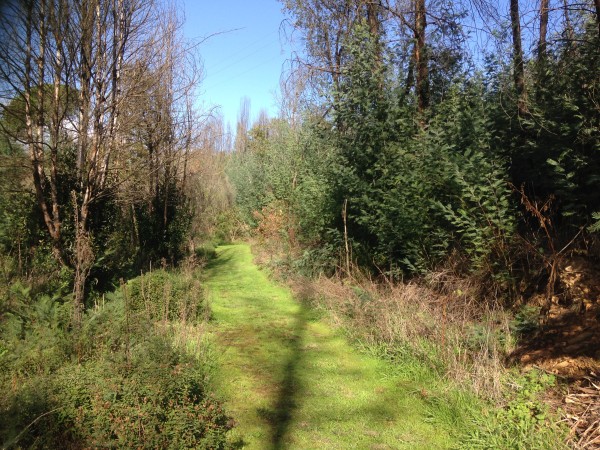
Forest road parting the burnt forest
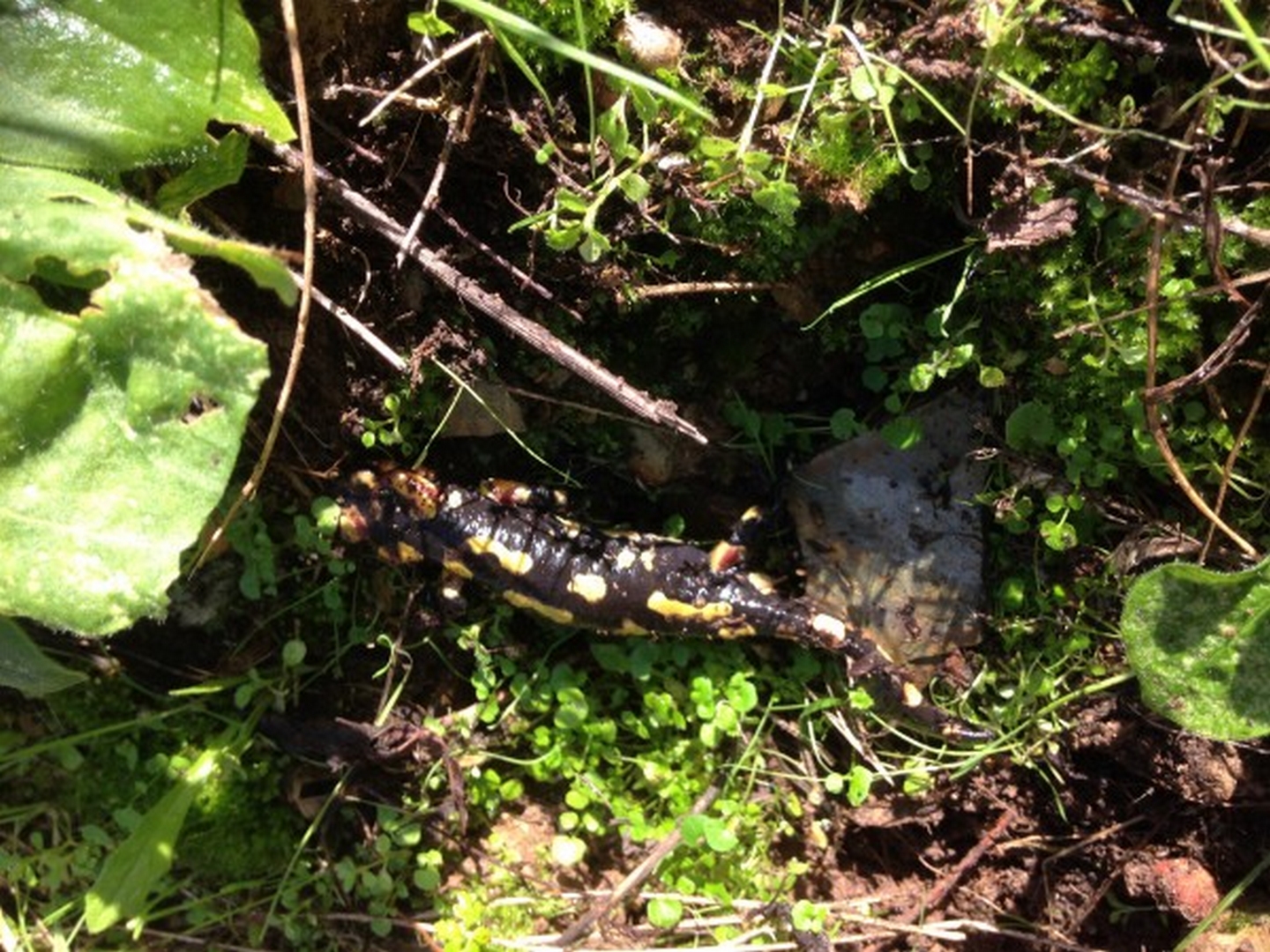
Salamander discovered on uprooting Acacia dealbata
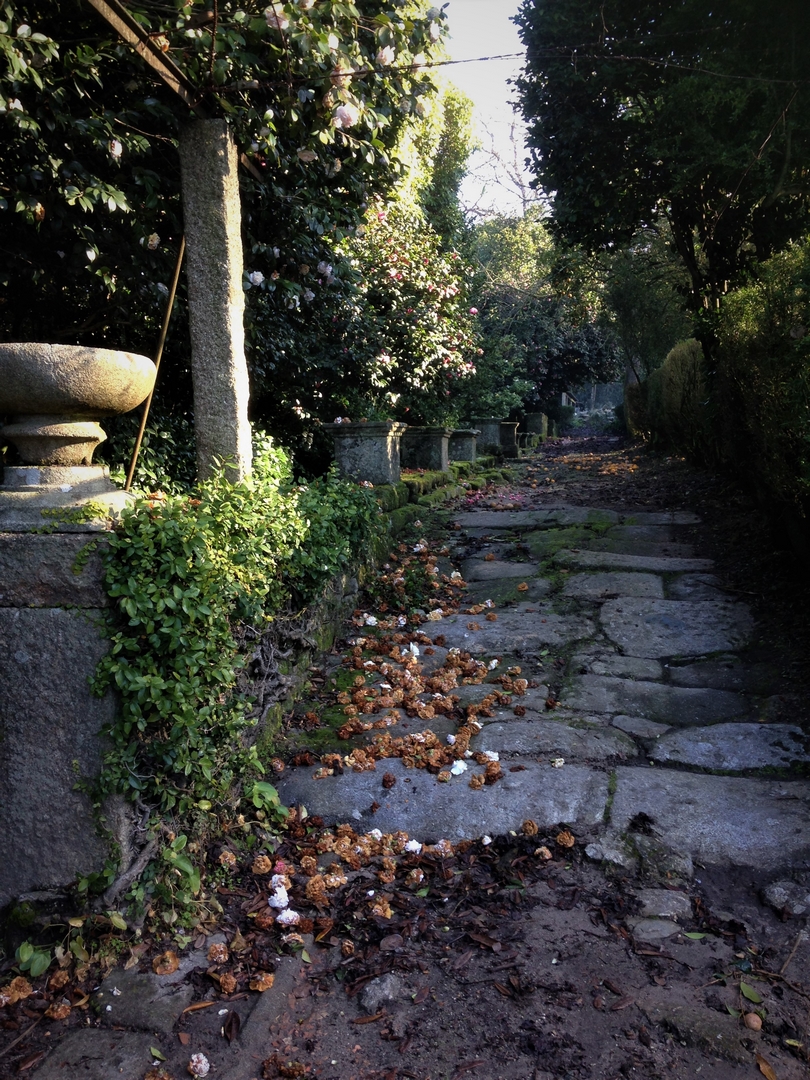
Path next to the orchard
Henriqueta loves the gardens but freely admits that she has very little experience in managing them. I was asked to do whatever I felt needed doing. Apart from linear surveying I did quite a lot of hazard assessments and some practical gardening. For a while I have been interested in the therapeutic benefits of gardening for people with disability so I welcomed the eager assistance of a local man, who despite cognitive impairments, seemed to enjoy all the measuring, pruning and planting. And although my Portuguese is very limited and he did not speak any English we somehow managed to understand each other and cooperate successfully. There is a very much overgrown Camellia garden which is being used as a reception during the events. The owner recently became a member of the Camellia Society in Porto and more focused development in this part of the garden is to be expected.
In places the soil was in a rather poor state and the light levels there were very low. As the funds for the garden are limited, and I am personally inclined towards low resource solutions that are easy on the planet, I suggested lifting some of the ground cover plants found around the property and replanting them (e.g. variegated Lamium maculatum, Hedera helix and Nephrolepis exaltata). Dr. Kingsbury suggested additional plants that could be purchased locally (e.g. Adiantum venustum and Liriope muscari). At this point I realised that horticultural knowledge and the range of plants on offer in Portuguese nurseries is far less than I have become used to in Britain.
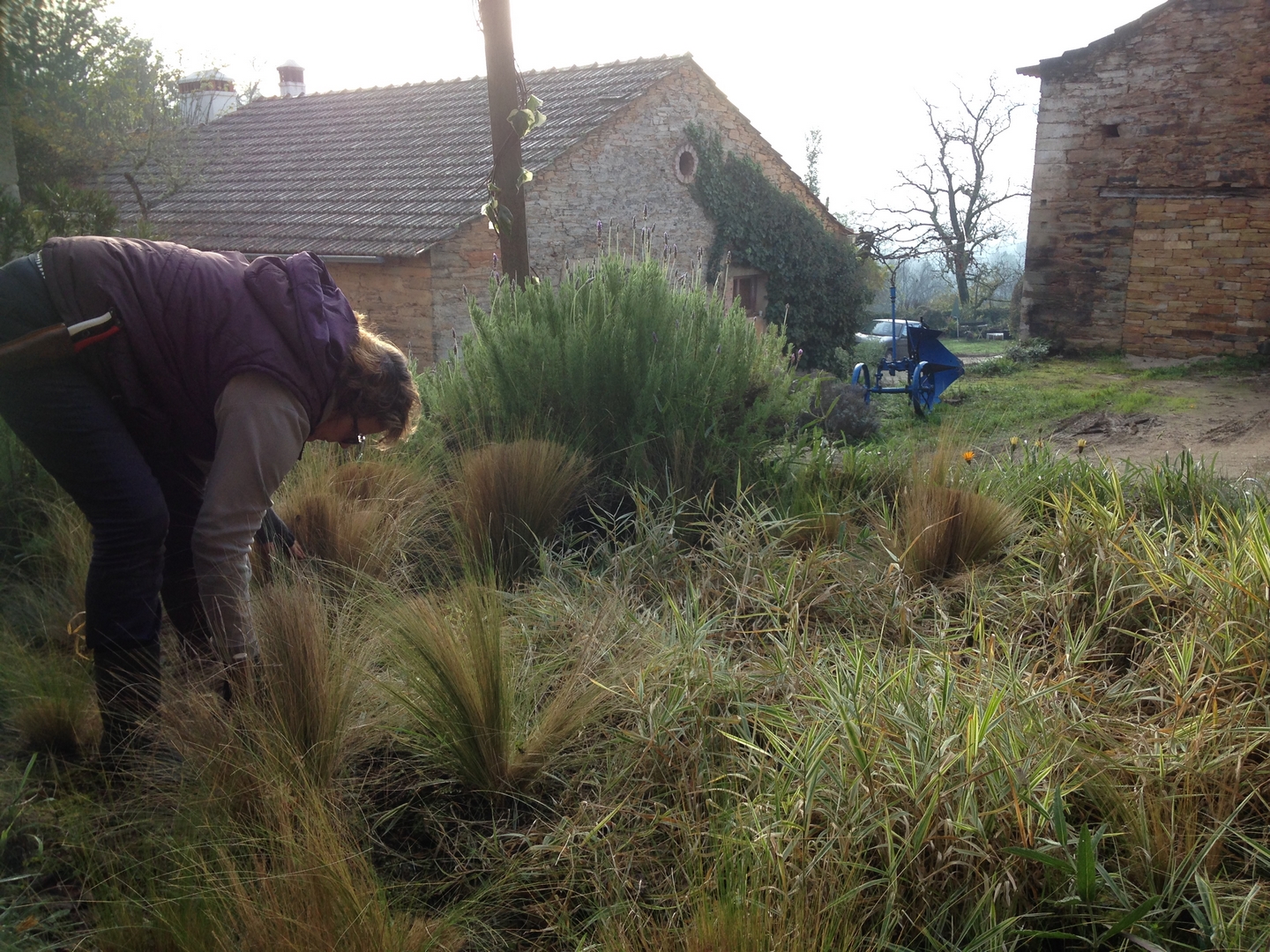
Karen, head gardener
This assignment made me realise the problems relating to invasive species and the ongoing conflict between commercial plantation and the loss of endemic habitat and ecological diversity. The prevalence of eucalyptus was something I previously came across while working in Chile where the success of invasive gum trees comes at the expense of local species and increased occurrence of wildfire. I was fascinated to read the history of commercial forestation of non-native Eucalyptus within Portugal. The dominance of Acacia and Eucalyptus sp. contributed greatly to the devastating wildfires of June 2017. This is why it is great to see the efforts being made by conservation groups such as Wildlings Portugal who we joined on one planting day to help reintroduce Quercus robur, Arbutus unedo and other native species.
At the beginning of January, I worked at Moistero De Santa Maria de Landim, 40 km north-east of Porto, a beautiful 12th century monastery with extensive vineyards, orchards, woodlands and formal gardens.
The gardens have been more or less left to their own devices which has created an enchanted feel to the place. The owner of the property, Maria Henriqueta Sampaio da Nóvoa, who is a lecturer at Porto University, is trying to restore the place to its former glory and the garden is used for wedding events during the year which helps to raise funds for ongoing restoration.
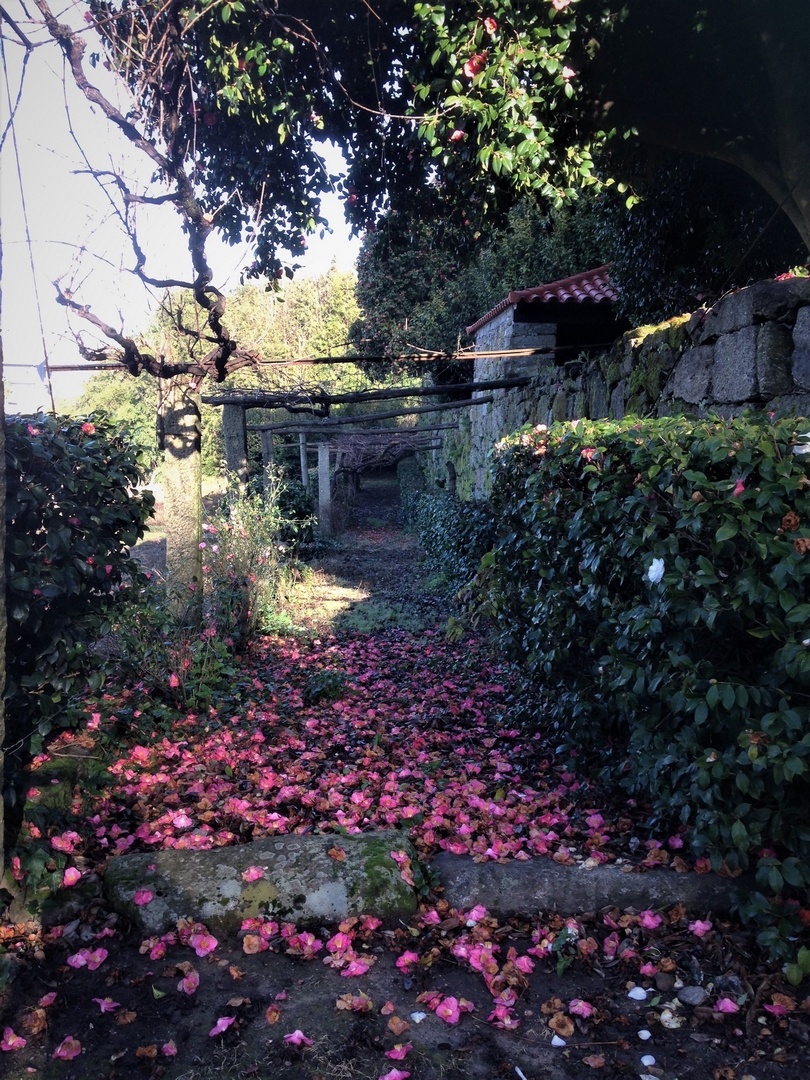
Path leading to the water reservoir
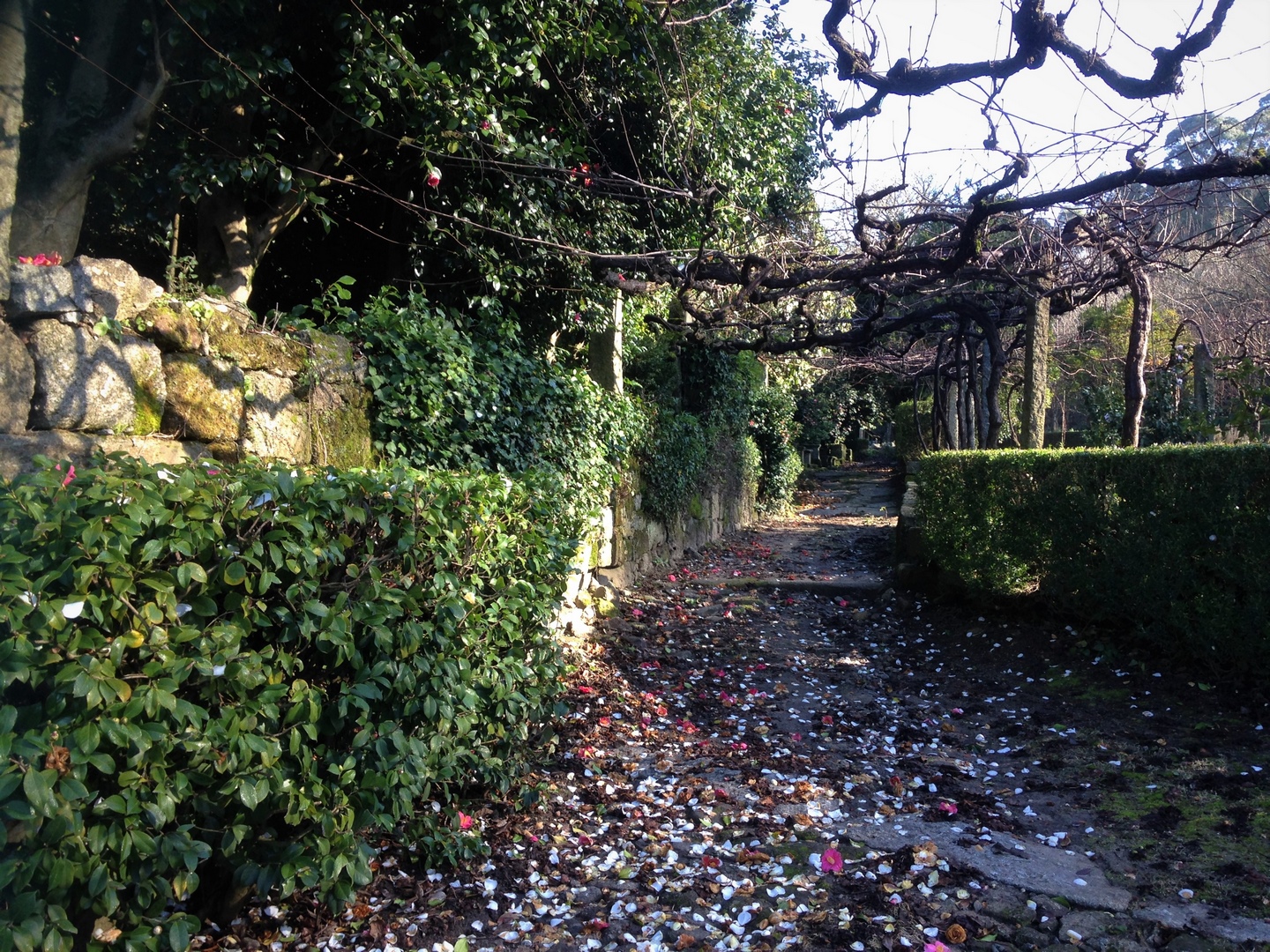
My final assignment at the end of January took me to Pedrógão Grande, the region most affected by catastrophic fires in 2017 to work in The Gardens of the Quinta das Mil Flores owned by the Countess de La Panouse.
Given the freedom to develop the garden as she wished the Countess has produced distinct garden areas always with ecological criteria at heart. Later in the year many visitors are attracted by the extensive rose garden but at the time of my stay it was the spiral citrus garden that stole the show. I was most impressed by the sophisticated organic kitchen garden and the ongoing project to manage water resources intelligently.
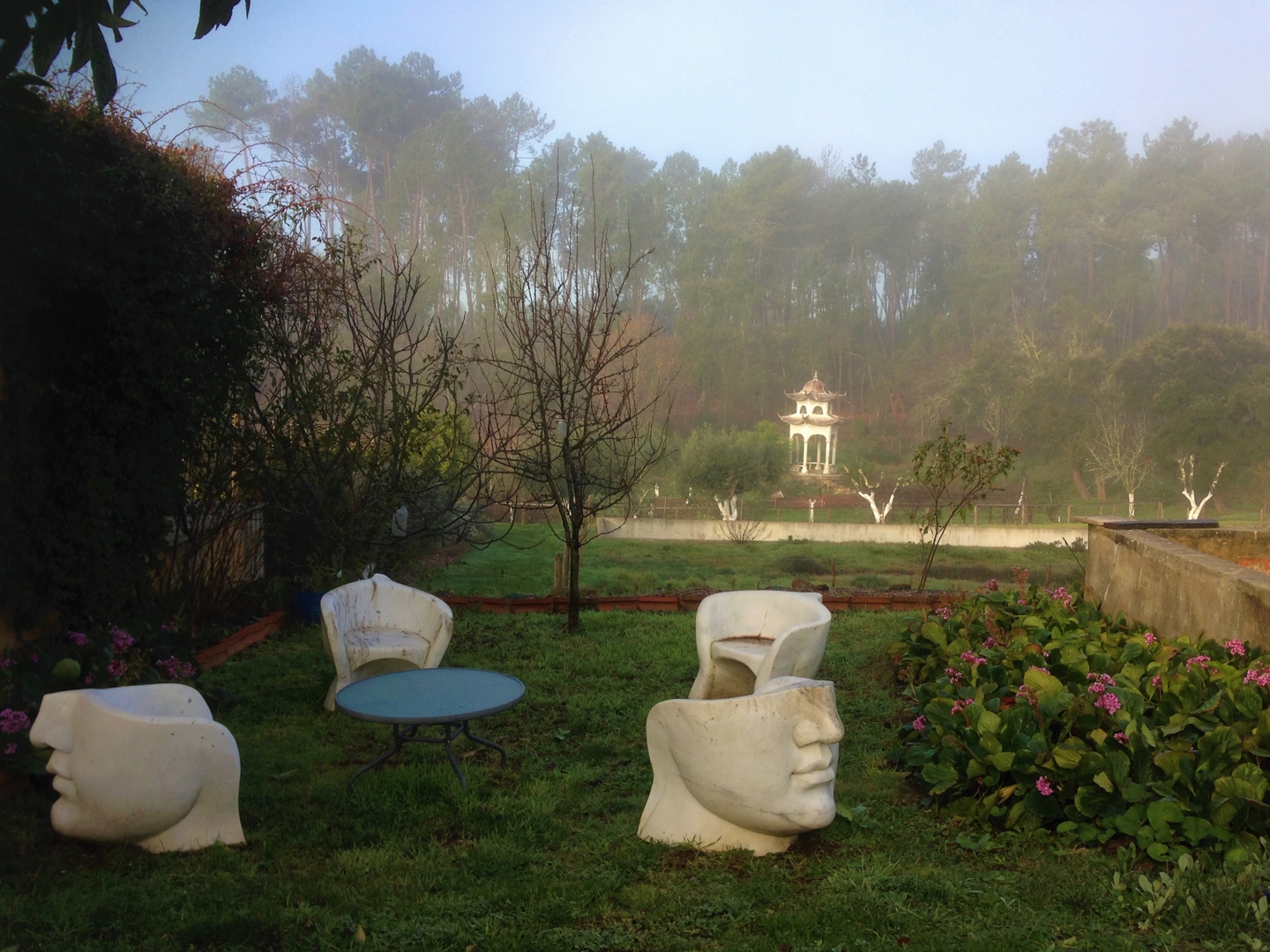
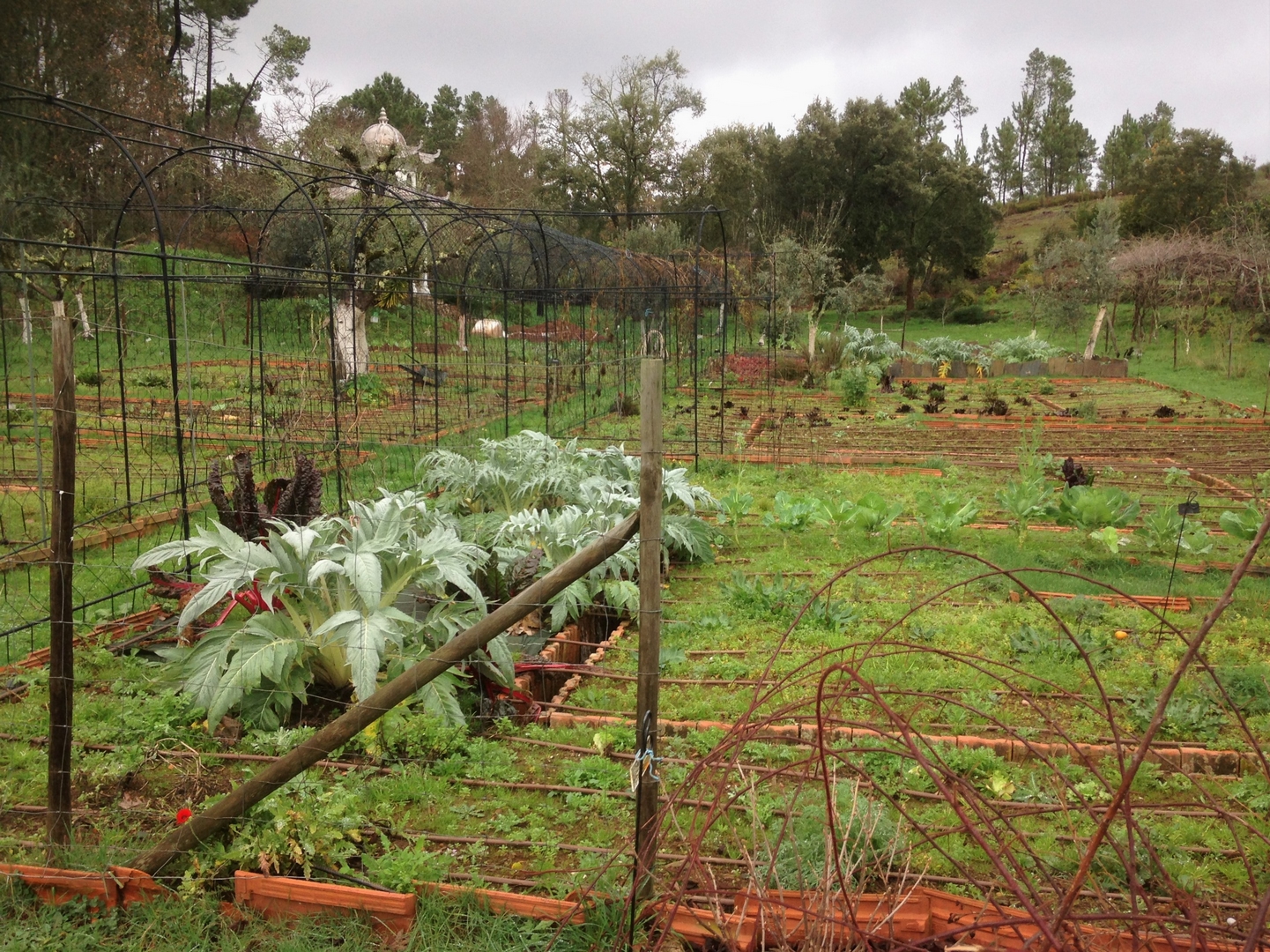
The vegetable garden with an intricate water system
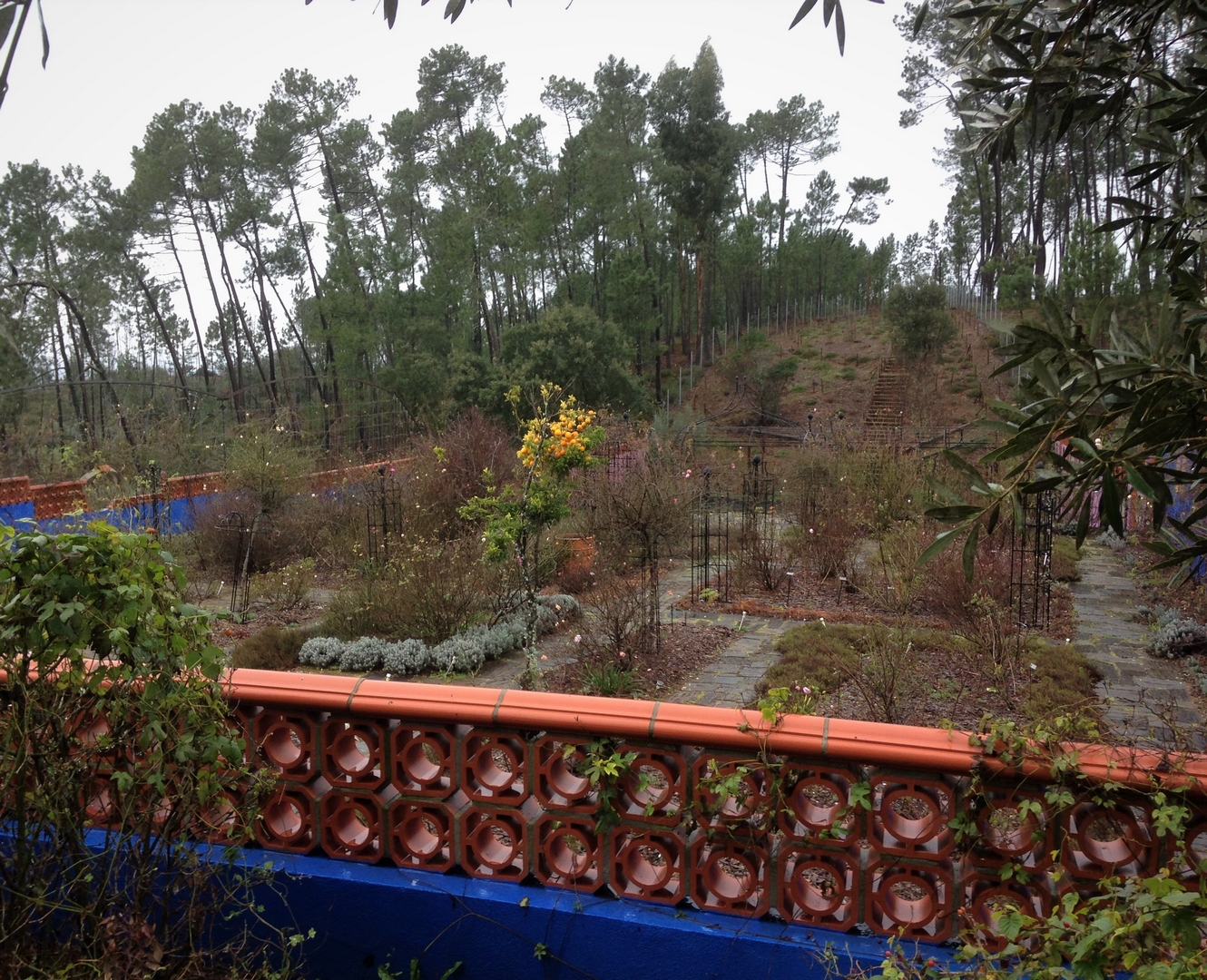
The sleeping rose garden
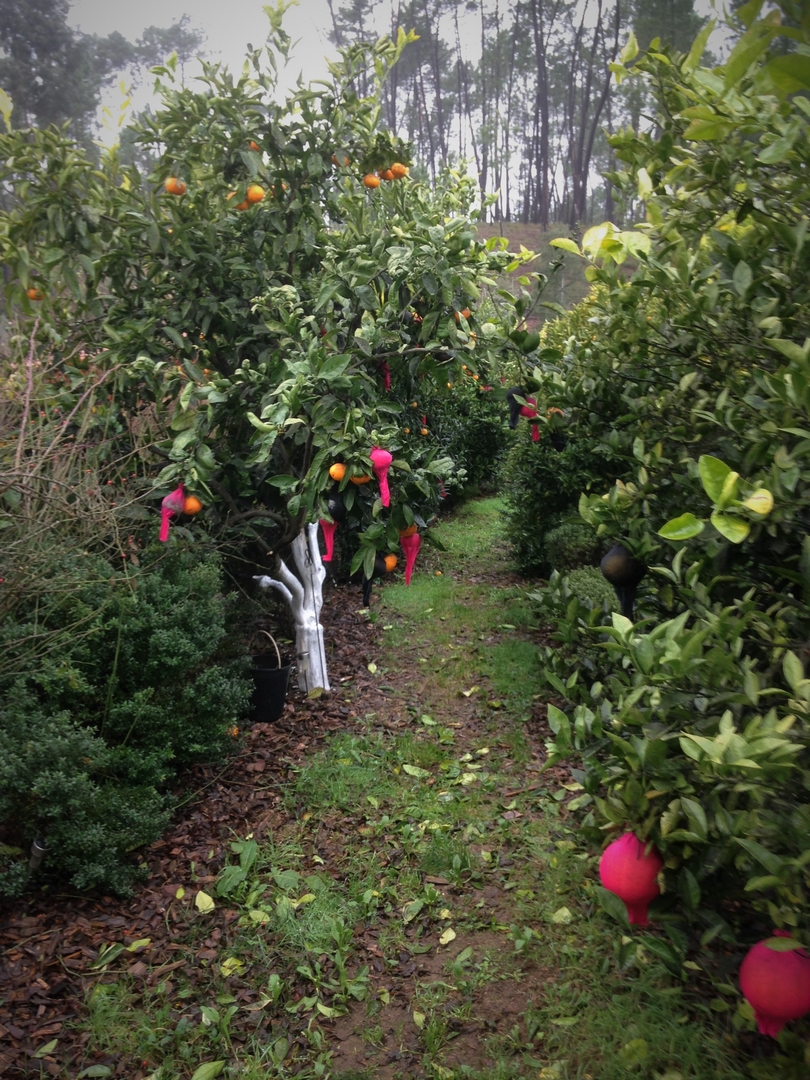
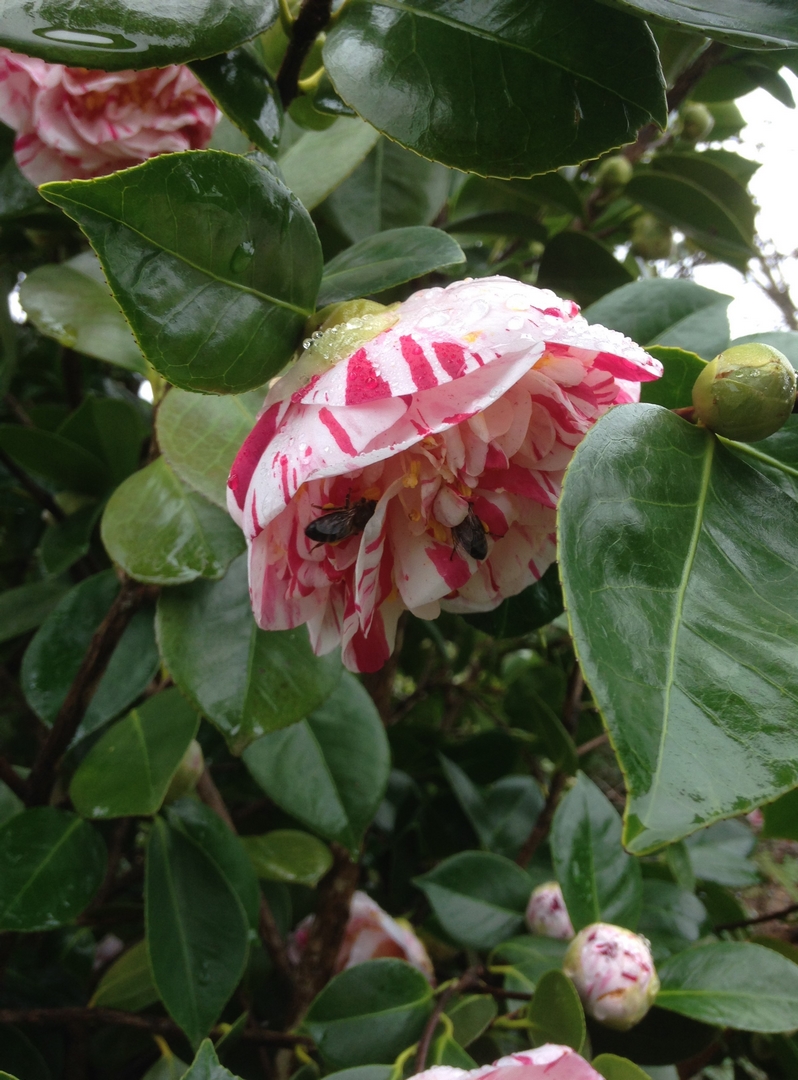
Camellia ‘Kick Off’ and busy bees
Rejuvenation of the herbal garden after its winter rest and taking cuttings of herbaceous plants were my last Portuguese tasks.
After my experiences in Portugal I am resolved to deepen my interest in sustainable design and be more involved in organisations that are acting to restore native flora and fauna where it has been devastated by undesirable human activity.
It has been instructive to be part of the early stages of a water-wise garden project and I am really keen to see how it develops. As my RHS level 3 studies progress I hope to return to Portugal.
I would like to thank MPG, the RHS and the Hardy Plant Society for providing me with funds from their bursary schemes. I have been so impressed by the consistency of support from Heather Martin, Cathy Rollinson, Susie Warwick and Lesley Jones. Special thanks, too to my tutors at Bicton College, Janice Hindley and Patrick Welch.
My deep gratitude also goes to the garden owners who allowed me to stay and work in their well-established gardens and most of all to Dr. Noel Kingsbury for giving me this wonderful opportunity and co-ordinating such a wide-ranging programme of work in Central Portugal.
Hana Váňová
PLANTS
elargonium Fibrex
P. unknown ‘Angel’
P. unknown Sc.fol.
P. ‘Rapture’
P. ‘Prince of Orange’
P. ‘The Mole’
Salvia Fox
S. africana
S. barrelieri
S. ‘Black Knight’
S. chamaedryoides
S. chionophylla
S. curviflora
S. darcyi ‘J. Compton’
S. ‘Dyson’s Crimson’
S. greggii ‘Peach’
S. guaranitica ‘Black and Blue’
S. leucantha
S. microphylla ‘Bordeaux’
S. regla
S. roemeriana ‘Red Dwarf’
S. sagittata
S. Spathacea
S. ‘Waverly’
Hill House
Abutilon ‘Patrick Synge’
A. ‘Nabob’
A. ‘Canary Bird’
Solanum wendlandii
Passiflora exoniensis
Clerodendron ugandense
Open-Pollinated Hellebore Seed Mix supplier: Barnhaven
Primula
P. ‘Garnet Cowichan’
P. ‘Muted Victorians’
P. acaulis ‘Osiered Amber’
Allium stipitatum supplier: Peter Nyssen
Narcissus
N. ‘Conspicuus ‘
N. ‘Mother Duck’
N. ‘Jack Snipe ‘
N. Martinette
N. poeticus var. recurvus (Pheasant Eye)
N. ‘Falconet ‘
Dutch Iris ‘Miss Saigon ‘
Lilium candidum (Madonna Lily)
Ixia Giant
Muscari armeniacum
Galanthus elwesii
Urginea maritima
Tulip praestans
Tulip tarda (Dasystemon)
Tulip kolpakowskiana
SEEDS
Pulsatilla vulgaris ‘Rote Glocke’
Allium ursinum
Linaria vulgaris
Origanum vulgare wild form
Ruta graveolens
Satureja montana
Teucrium chamaedrys hort.
Alcea (Althaea) Ficifolia-Hybr.
Allium carinatum ssp. pulchellum
Anthemis carpatica ‘Karpatenschnee’
Arum italicum ssp. italicum
Asphodeline lutea
Baptisia pendula
Centranthus ruber var. coccineus
Convolvulus cantabricus
Eriogonum fasciculatum
Eriogonum umbellatum
Gaura lindheimeri
Ladiolus illyricus
Goniolimon tataricum
Gypsophila repens ‘Rosea’
Helichrysum bellidioides
Jurinea mollis
Lavandula angustifolia Munstead-Strain
Limonium perezii
Linaria genistifolia ssp. dalmatica
Lychnis chalcedonica
Lychnis viscaria wild form
Marrudium incanum
Mirabilis jalapa Mixture
Nepeta racemosa ‘Felix’
Papaver Orientale-Hybr. ‘Königin Alexandra’
Penstemon barbatus ssp. coccineus
Perovskia atriplicifolia
Salvia cyanescens
Salvia nemorosa
Sedum spurium var. coccineum
Sedum stoloniferum
Teucrium montanum
Thymus comosus
Thymus longiflorus
Thymus serpyllum ‘Magic Carpet’
Ampelodesmos mauritanicus
Festuca mairei
Agapanthus africanus ‘Big Blue’
Antirrhinum ‘Angel Towers’
Brugmansia ‘Ecuador Pink’
Aquilegia Cottage garden mix
Bupleurum fruitcosum
Cerinthe major ‘Yellow Gem’
CIistus ‘Pink Silk’
CIistus sintenisii
Eryngium X oliverianum
Eryngium mixed
Geranium endressii
Geranium macrorrhizum ‘Czakor’
Geranium sanguineum
Iberis umbellata
Lilium regale
Mala ‘Gibbortello’
Musa ‘Tiger Stripes’
Muscari leucostomum
Muscari neglectum
Phlomis russeliana
Oenothera odorata
Phlomis tuberosa
Verbascum thapsus

